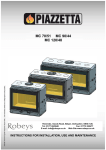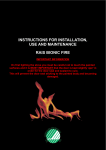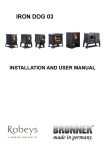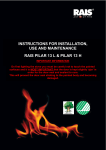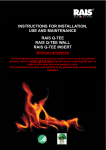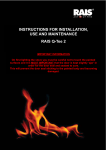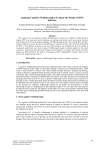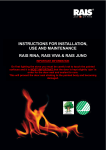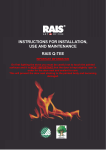Download Robeys Piazzetta 650 HT Specifications
Transcript
Robeys Ltd Riverside, Goods Road, Belper, Derbyshire. DE56 1UU Tel: 01773 820940 Fax: 01773 820477 Email: [email protected] Web Site www.robeys.co.uk 1 SUPPLEMENTARY INSTALLATION INSTRUCTIONS FOR THE UK MARKET TO BE READ IN CONJUNCTION WITH THOSE IN THE INSTRUCTION BOOKLET READ THE INSTRUCTION BOOKLET AND THESE SUPPLEMENTARY INSTRUCTIONS CAREFULLY BEFORE INSTALLATION These instructions together with those in the instruction booklet cover the basic principles to ensure the satisfactory installation of the stove, although detail may need slight modification to suit particular local site conditions. In all cases the installation must comply with current Building Regulations, Local Authority Byelaws and other specifications or regulations as they affect the installation of the stove. It should be noted that the Building Regulations requirements may be met by adopting the relevant recommendations given in British Standards BS 8303, BS 6461 and BS 7566 as an alternative means to achieve an equivalent level of performance to that obtained following the guidance given in Approved Document J. Please note that it is a legal requirement under England and Wales Building Regulations that the installation of the stove is either carried out under Local Authority Building Control approval or is installed by a Competent Person registered with a Government approved Competent Persons Scheme. HETAS Ltd operate such a Scheme and a listing of their Registered Competent Persons can be found on their website at www.hetas.co.uk. HEALTH AND SAFETY PRECAUTIONS Special care must be taken when installing the stove such that the requirements of the Health and Safety at Work Act are met. Handling Adequate facilities must be available for loading, unloading and site handling. Fire Cement Some types of fire cement are caustic and should not be allowed to come into contact with the skin. In case of contact wash immediately with plenty of water. Asbestos This stove contains no asbestos. If there is a possibility of disturbing any asbestos in the course of installation then please seek specialist guidance and use appropriate protective equipment. Metal Parts When installing or servicing this stove care should be taken to avoid the possibility of personal injury. STOVE PERFORMANCE In the UK the stove has been approved by HETAS Ltd as an intermittent operating appliance for burning wood logs only. It should be noted that it is an offence to burn wood logs in this stove if it is installed within a Smoke Control Area in the UK, unless it has been accredited as a Smoke Control Exempt appliance (Check with your supplier/installer). Page 1 2 PREPARATORY WORK AND SAFETY CHECKS IMPORTANT WARNING This stove must not be installed into a chimney that serves any other heating appliance. There must not be an extractor fan fitted in the same room as the stove as this can cause the stove to emit fumes into the room. Chimney In order for the stove to perform satisfactorily the chimney height must be sufficient to ensure an adequate draught of approximately 15 Pa so as to clear the products of combustion and prevent smoke problems into the room. NOTE: A chimney height of not less than 4.5 metres measured vertically from the outlet of the stove to the top of the chimney should be satisfactory. Alternatively the calculation procedure given in BS 5854:1980 may be used as the basis for deciding whether a particular chimney design will provide sufficient draught. The outlet from the chimney should be above the roof of the building in accordance with the provisions of Build ing Regulations Approved Document J. If installation is into an existing chimney then it must be sound and have no cracks or other faults which might allow fumes into the house. Older properties, especially, may have chimney faults or the cross section may be too large i.e. more than 230 mm x 230 mm. Remedial action should be taken, if required, seeking expert advice, if necessary. If it is found necessary to line the chimney then a flue liner suitable for solid fuel must be used in accordance with Building Regulations Approved Document J. Any existing chimney must be clear of obstruction and have been swept clean immediately before installation of the stove. If the stove is fitted in place of an open fire then the chimney should be swept one month after installation to clear any soot falls which may have occurred due to the difference in combustion between the stove and the open fire. If there is no existing chimney then either a prefabricated block chimney in accordance with Building Regula tions Approved Document J or a twin walled insulated stainless steel flue to BS 4543 can be used. These chimneys must be fitted in accordance with the manufacturer’s instructions and Building Regulations. A single wall metal fluepipe is suitable for connecting the stove to the chimney but is not suitable for using for the complete chimney. The chimney and connecting fluepipe must have a minimum diameter of 150 mm and its dimension should be not less than the size of the outlet socket of the stove. Any bend in the chimney or connecting fluepipe should not exceed 45°. 90° bends should not be used. Combustible material should not be located where the heat dissipating through the walls of fireplaces or flues could ignite it. Therefore when installing the stove in the presence of combustible materials due account must be taken of the guidance on the separation of combustible material given in Building Regulations Approved Document J and also in these stove instructions. If it is found that there is excessive draught in the chimney then either an adjustable flue damper or alternatively a draught stabiliser should be fitted. The adjustable flue damper should not close off the flue entirely but should in its closed position leave a minimum continuous opening free area of at least 20 % of the total cross sectional area of the flue or fluepipe. Adequate provision e.g. easily accessible soot door or doors must be provided for sweeping the chimney and connecting fluepipe, also to permit visual checks on the integrity of the flue when the appliance is serviced. Page 2 3 Hearth The hearth should be able to accommodate the weight of the stove and its chimney if the chimney is not independently supported. The weight of the stove is indicated in the brochure. The stove should always be installed on a noncombustible hearth of a size and construction that is in accordance with the provisions of the current Building Regulations Approved Document J. The clearance distances to combustible material beneath, surrounding or upon the hearth and walls adjacent to the hearth should comply with the guidance on the separation of combustible material given in Building Regulations Approved Document J and also in these stove instructions. If the stove is to be installed on a wooden floor, it must be covered with a noncombustible material at least 12mm thick, in accordance with Building Regulations Approved Document J, to a distance of 30 cm in front of the stove and 15 cm to each side measuring from the door of the combustion chamber. Combustion air supply In order for the stove to perform efficiently and safely there should be an adequate air supply into the room in which the stove is installed to provide combustion air. This is particularly necessary if the room is double glazed or a flue draught stabiliser is operating in the same room as the appliance. It may be necessary to increase the air vent size in property with low air permeability ( < 5.0 m 3 /(h.m 2 ). The provision of air supply to the stove must be in accordance with current Building Regulations Approved Document J. An opening window is not appropriate for this purpose. Connection to chimney All the stoves have a rear and/or top flue gas connector that allows connection to either a masonry chimney or a prefabricated factory made insulated metal chimney in accordance with the instructions for the appliance given in the instruction booklet. Carbon Monoxide Alarm A carbon monoxide alarm complying with BS EN 50291 must be fitted in the same room as the appliance in accordance with the current Building Regulations Part J. It should be positioned on the ceiling at least 300mm from any wall or, if it is located on a wall, as high up as possible (above any doors and windows) but not within 150mm of the ceiling. The alarm should also be between 1m and 3m horizontally from the appliance. Commissioning and handover Ensure loose parts are fitted in accordance with the instructions given in the instruction booklet. On completion of the installation allow a suitable period of time for any fire cement and mortar to dry out, when a small fire may be lit and checked to ensure the smoke and fumes are taken from the stove up the chimney and emitted safely to atmosphere. Do not run at full output for at least 24 hours. On completion of the installation and commissioning ensure that the operating instructions for the stove are left with the customer. Ensure to advise the customer on the correct use of the appliance with the fuels likely to be used on the stove and warn them to use only the recommended fuels for the stove. Advise the user what to do should smoke or fumes be emitted from the stove. The customer should be warned to use a fireguard to BS 6539 in the presence of children, aged and/or infirm persons. Page 3 4 SUPPLEMENTARY OPERATING INSTRUCTIONS FOR THE UK MARKET TO BE READ IN CONJUNCTION WITH THOSE IN THE INSTRUCTION BOOKLET READ THE INSTRUCTION BOOKLET AND THESE INSTRUCTIONS CAREFULLY BEFORE USING THE STOVE WARNING NOTE Properly installed, operated and maintained this stove will not emit fumes into the dwelling. Occasional fumes from deashing and re‑fuelling may occur. However, persistent fume emission is potentially dangerous and must not be tolerated. If fume emission does persist, then the following immediate action should be taken: ‑ (a) Open doors and windows to ventilate room (b) Let the fire out or eject and safely dispose of fuel from the appliance (c) Check for flue or chimney blockage and clean if required (d) Do not attempt to relight the fire until the cause of the fume emission has been identified and corrected. If necessary seek expert advice. The most common cause of fume emission is flue way or chimney blockage. For your own safety these must be kept clean at all times. IMPORTANT NOTES General Before lighting the stove check with the installer that the installation work and commissioning checks described in the installation instructions have been carried out correctly and that the chimney has been swept clean, is sound and free from any obstructions. As part of the stoves’ commissioning and handover the installer should have shown you how to operate the stove correctly. Use of fireguard When using the stove in situations where children, aged and/or infirm persons are present a fireguard must be used to prevent accidental contact with the stove. The fireguard should be manufactured in accordance with BS 6539. If the fire is left unattended a spark guard to BS 3248, specification for spark guards for use with solid fuel appliances should be used. Chimney cleaning The chimney should be swept at least once a year for smokeless fuels and a minimum of twice a year for wood and other fuels. It is important that the flue connection and chimney are swept prior to lighting up after a prolonged shutdown period. If the stove is fitted in place of an open fire then the chimney should be swept one month after installation to clear any soot falls which may have occurred due to the difference in combustion between the stove and the open fire. In situations where it is not possible to sweep through the stove the installer will have provided alternative means, such as a soot door. After sweeping the chimney the stove flue outlet and the flue pipe connecting the stove to the chimney must be cleaned with a flue brush. Page 4 5 Extractor fan There must not be an extractor fan fitted in the same room as the stove as this can cause the stove to emit smoke and fumes into the room. Aerosol sprays Do not use an aerosol spray on or near the stove when it is alight. Use of operating tools Always use the operating tools provided when handling parts likely to be hot when the stove is in use. Chimney Fires If the chimney is thoroughly and regularly swept, chimney fires should not occur. However, if a chimney fire does occur turn the air control setting to the minimum, and tightly close the doors of the stove. This should cause the chimney fire to go out in which case the control should be kept at the minimum setting until the fire in the stove has gone out. The chimney and flueways should then be cleaned. If the chimney fire does not go out when the above action is taken then the fire brigade should be called immediately. After a chimney fire the chimney should be carefully examined for any damage. Expert advice should be sought if necessary Permanent air vent The stove requires a permanent and adequate air supply in order for it to operate safely and efficiently. In accordance with current Building Regulations the installer may have fitted a permanent air supply vent into the room in which the stove is installed to provide combustion air. This air vent should not under any circumstances be shut off or sealed. HETAS Ltd Approval Please note that HETAS Approval only covers the use of wood on the stove and approval does not cover the use of other fuels either alone or mixed with other fuels, nor does it cover instructions for the use of other fuels. USER OPERATING INSTRUCTIONS WOOD The instructions detailed in the section / in the instruction booklet should be followed. Door operation The door handle may become hot during operation, use the tool to open and close the doors, if appropriate. Lighting of fire Place some firelighters or paper and dry kindling wood on the grate and cover with a small amount of fuel. Set air controls to maximum and set light to firelighters or paper. Close the doors and allow fire to burn until fuel is well alight then load with more fuel and adjust air controls to the required level of heat output. Before relighting the fire clean the fire bed of ash and clinker and empty the ash pan. Page 5 6 Refuelling Keep the firebox well filled (the fuel may be sloped up from the front fire bars), but do not allow fuel to spill over the top of the front fire bars. Take care that fuel does not project over the front fire bars or damage to the glass may be caused when the doors are closed Flueway cleaning It is important that the baffle plate and all the stove flue ways are kept clean. When burning smokeless fuels they should be cleaned at least monthly. When burning other fuels they should be cleaned at least once a week, and more frequently if necessary. Remove any sooty deposits from the baffle plate until they fall off into the fire. More soot will be deposited on the baffle plate and in the flue ways if the stove is run at low levels for long periods. If this is the case then more frequent cleaning will be necessary. Cleaning and maintenance The instructions detailed in the section “Maintenance” in the instruction booklet should be followed. Trouble shooting The instructions detailed in the relevant section in the instruction booklet should be followed together with the following additional items: 1. Fire Will Not Burn Check that: a) the air inlet is not obstructed in any way, b) that chimneys and flue ways are clear, c) that a suitable fuel is being used, d) that there is an adequate air supply into the room, e) that an extractor fan is not fitted in the same room as the fire. 2. Fire Blazing Out Of Control Check that: a) the doors are tightly closed, b) the air control is turned down to the minimum setting, c) the air inlet damper is closed and that it is not prevented from closing completely by a piece of ash, d) a suitable fuel is being used, e) the door seals are in good condition. Registered Office: Robeys Ltd, Goods Road, Belper Derbyshire DE56 1UU Tel +44(0)1773 820940 Fax +44(0)1773 820477 Email [email protected] www.robeys.co.uk Company No. 5741182 Director: Mark Robey Company Secretary: Sharon Robey Page 6 7 8 Section Heading Page 1.0 1.1 1.2 1.3 1.4 1.5 1.6 1.7 1.8 1.9 1.10 1.11 1.12 1.13 1.14 1.15 1.16 GENERAL RULES Single chimney or flue way Soot inspection Chimney stack Fresh air intake Installation environment Load bearing capacity of the floor Heating capacity Methods of heat diffusion Suitable heat insulating materials Minimum safety distances Connection to the flue way Lining the wall Hood grille Wood mantel protection Electric power supply Prevention of domestic fires 10 11 11 12 13 14 14 14 15 16 17 18 19 19 19 20 20 2.1 2.2 2.3 2.4 2.5 2.6 TECHNICAL DATA AND SPECIFICATIONS Description of the appliance Accessories Features Product identification data Technical data Fireplace dimensions 21 21 22 22 22 23 23 3.0 PREPARATION FOR INSTALLING 26 4.0 INSTALLATION OF THE SMOKE REGISTER 27 5.1 5.2 5.3 5.4 5.5 5.6 5.7 5.8 5.9 USE Fuel Smoke damper regulation Combustion air regulation Lighting for the first time Lighting Opening the door Night time operation at a minimum Operation under adverse weather conditions Over heating and extinguishing 28 28 29 30 30 31 31 31 32 32 6.1 6.2 6.3 6.4 6.5 6.6 6.7 6.8 6.9 6.10 6.11 6.12 MAINTENANCE Periodic control Cleaning the ceramic cladding Cleaning the steel parts Cleaning the painted metal parts Cleaning the glass Cleaning the grate and the ash tray Disposal of the ashes Cleaning the Aluker Removing the smoke baffle plates Cleaning the fan Shutting down Closing door system 33 33 33 33 33 34 34 34 34 35 35 35 35 TROUBLESHOOTING Certificate of Conformity Quick Guides 36 39 42 2.0 5.0 6.0 7.0 9 CHIMNEY POT INSPECTION / SOOT DOOR CONTROL FOR FLUE DAMPER. NOTE, CAN BE ON SIDE. FIXED AIR OUTLET CHECK FLOOR FOR LOAD BEARING CAPACITY 10 11 The illustration and table identify the minimum requirements as dictated by Building Regulations Fig . 10/11 12 13 14 15 16 17 18 19 20 21 22 23 24 25 26 27 28 29 30 31 32 33 34 35 36 37 38 39 40 41 42 43 44 45 Robeys Ltd Goods Road, Belper, Derbyshire. DE56 1UU Tel 01773 820940 Fax 01773599309 Email [email protected] www.robeys.co.uk 46














































